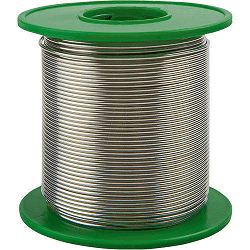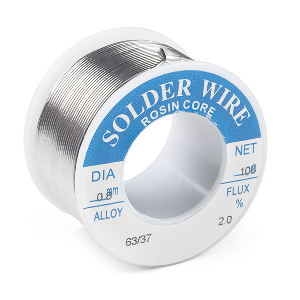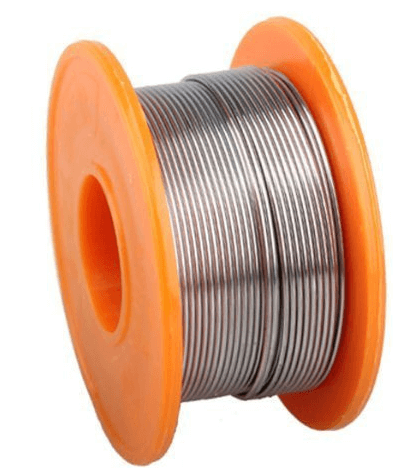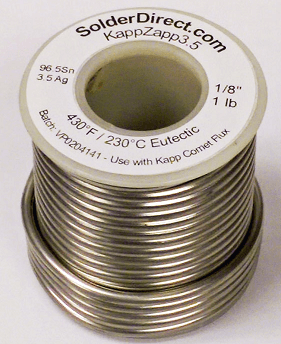What is Solder?
If you are even slightly familiar with electronics and circuit boards, then you might have heard of Soldering. What exactly is Soldering? Soldering is a metallurgical joining of two metals using a filler element with a melting point around 315°C or 600°F.
How to solder wires? What is a solder mask? How to remove solder? How hot does a soldering iron get? How to clean soldering iron?
The filler element is nothing but the Solder, which is a metal alloy. Solder Alloys usually consists of the following elements: Lead (Pb), Tin (Sn), Silver (Ag), Bismuth (Bi), Antimony (Sb), Indium (In), and Cadmium (Cd). Out of these, Lead (Pb) and Tin (Sn) are the main elements that are used in a variety of Solders specifically for soft soldering (soldering electronic components). However, the use of Lead (Pb) is gradually decreasing, at least in the industrial stage (PCB Assembly), due to toxic nature of Lead. Hence, modern large-scale soldering uses Lead-free Solder. But for small-scale jobs and individual or hobbyist soldering, lead-based solder is still a popular choice. The main criterion for selecting a Solder is that the melting point of the solder should be lower than the melting points of the metals that have to be joined. Only then, the solder will melt before the metals and join them together. The melting point of the solder depends on the mixture of alloys. Take a look at the following table that has different types of Solder which we use commonly in electronic industry, jewelry, plumbing, etc. Solders are classified into different types based on their composition. Similarly, they are also classified based on their form, core style, and composition. Besides this, there are certain solders designed specifically for joining certain metals. Examples of such solders are aluminum solder and cast iron solder.
Types of Solder by Composition
Based on the composition, solders are categorized into four different types. They are as follows,
1. Lead Alloy Solders
In this solder type, lead is mixed with other alloys to get the required melting point and tensile strength. They are also known as soft solders. The most commonly used alloy along with the lead in this mixture is tin. They are mixed in the ratio of 60/40 (tin/lead). The melting point of this mixture is 180 to 1900C. The reason that tin is preferred is because of its low melting point. Apart from this, tin also increases the tensile and shear strength. Lead, on the other hand, inhibits the growth of tin bristles.
2. Lead-Free Solders
As the name suggests, these solders do not contain any lead. The lead-free solders have a higher melting point than the lead alloy solders. You can get tax benefits in the U.S.A if you use lead-free solders. Lead is poisonous to your health and the environment. Hence, the federal government provides incentives to manufacturers using lead-free solders. Instead of nickel, you can use additives such as nickel and conformal coatings to prevent tin whiskers.
3. Flux-Core Solders
The flux core solder is available in the form of wires wounded on a cylindrical device. There is a reducing agent present at its core. During soldering, the flux is released and it removes the oxidized layer formed on the surface of the metal. As a result, the metal surface becomes clean and ready for soldering. Besides removing the oxidized layer, it increases the solder’s wetting properties. For soldering electronic components, rosin is used as a flux. For metal joining and plumbing, acid cores are used as a flux.
4. Silver Alloy Solders
The silver alloy solder can either be lead-free or lead-based solders. In the initial years, silver was only added to lead-based alloy solders. This was done to prevent an effect called silver migration. The silver present in the silver plating enters the solder. If this solder is applied to the metals before soldering, it makes the joints brittle and prone to breaking. The silver alloy solders come in different ratios of silver, lead, and other alloys. The cost of these solders depends on the ratio of these alloys.
Types of Solder by Core Style
Based on the type of core, solders are classified into three different types. They are as follows,
1. Acid Core Solder
In this acid core solder, the solder is in the form of wires that are wound over a hollow core. The hollow core consists of an acid-based flux that is aggressive and strong. The acid-based flux is effective in removing the metal oxide layer formed on the surface of the metal. Besides, it also prevents further oxidation of the metal. As a result, it produces joints that are solid and do not break. These solders are used to join steel and other metals. But you have to clean the flux residue after soldering to prevent corrosion in metals. Acid core solders are primarily used to join copper pipes and sheet metal in plumbing applications.
2. Rosin Core Solder
Similar to acid core solder, the rosin core solder also has a hollow core present inside the solder wire. The only difference is that this solder uses a mild flux that is made of rosin. The main advantage of this flux is that its residue does not cause corrosion. So, it is most commonly used in soldering electrical appliances because it is difficult to remove the residue in electrical connections.
3. Solid Core Solder
The solid core solder uses a solid wire containing the solder alloy or material, instead of a hollow core. They do not contain flux. You have to apply the flux separately if you are using this solder.
Types of Solder by Form Factor
Solder wires wound over a spool is the most common form of solder. But, besides this, there are many other forms of solder. The other common solder forms are solder strips, solder pellets, solder rods, solder foil, solder rings, and ribbon solders. The solder form is chosen depending on the application and the type of metal to be soldered. Apart from these, there are precoated solder washers that can automate the soldering process for through-hole components in the case of electronics.
Types of Solder by Application
Soldering finds its application most commonly in the field of plumbing and applications. Besides these, soldering is used in aircraft, radiative, automotive, and household repair. But the solders have to meet certain conditions to be used for soldering operations in these fields. For instance, aircraft solders have to be able to withstand vibration and thermal cycling. In the case of radiation repairs, automotive solders are used to seal leaks in the coolant heat exchangers of vehicles. There are also some specialized solders that are developed to solder specific metals. Normal solders are not so effective in soldering these metals. Examples of such solders are aluminum solder and cast iron solder.
Conclusion
To sum it up, the three main types of solder are lead-free solder, lead-based solder, and flux-core colder. These types are made based on the compositions of alloys. Besides these, there are other different types of solder depending on the core style, form, and applications. If you have any other doubts, please let us know using the comments section. My team will help you out. You can also post your thoughts and opinions in the comments box. Comment * Name * Email * Website
Δ









![]()